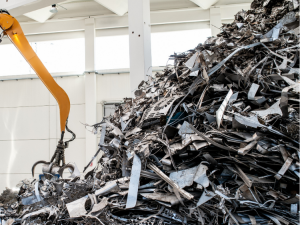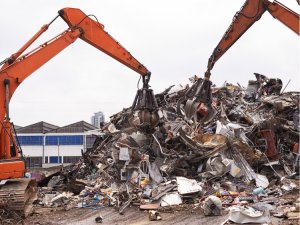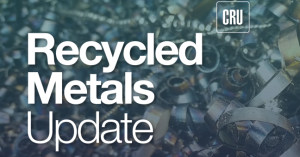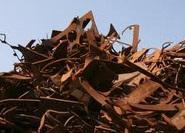
Algoma looks to sell more steel in Canada in wake of Trump's tariffs
The Canadian steelmaker said its absorbing higher tariffs as it moves forward.

The Canadian steelmaker said its absorbing higher tariffs as it moves forward.

Last week, much attention was focused on President Trump’s “Liberation Day” tariffs and rightly so. They have thrown a big wrench into the market-reading business. Whether you are for them or against them, the potential outcomes are hazy, at best. Maybe we should not forget the basics, tariffs concerns notwithstanding. The basics of this ferrous […]

SMU’s ferrous scrap market survey results are now available on our website to all premium members. After logging in at steelmarketupdate.com, visit the pricing and analysis tab and look under the “survey results” section for “ferrous scrap survey” results. Past flat-rolled survey results are also available under that selection. If you need help accessing the survey results, […]

MetalX Founder and CEO Danny Rifkin - born in 1954 - died on April 1, surrounded by family.

In the final week of February, SMU polled steel and scrap executives to gather their insights on the current state of the scrap market as well as future projections.

Buyers are optimistic for a strong scrap market in March, driven by limited scrap inflows from severe weather disruptions and increasing mill demand.

A majority of SMU survey respondents expect US prime scrap tags to land sideways in February. In our most recent survey last week, 51% said US prime scrap prices would be flat next month, and 46% anticipate rising prices; the small remainder think prices will fall. Recall that the January ferrous scrap market settled before […]

The US ferrous scrap market has essentially traded sideways for August. It may be too early to judge how much traction these prices will have with the trade.

Cleveland-Cliffs Chairman, President and CEO Lourenco Goncalves had some insightful things to say today about the steel market and about a conference we suspect might be Steel Summit.

Cleveland-Cliffs expects its acquisition of Canada’s Stelco to close later this year, which will help the the Cleveland-based steelmaker as a bottom to steel tags nears.

They say a picture is worth a thousand words. Well, when you add in some commentary from respected peers in the steel industry to those pictures, that may shoot you up to five thousand words, at least. In that spirit, we’ve added some snapshots from our market survey this week, along with some comments from market participants.

The spread between hot-rolled coil (HRC) and prime scrap prices narrowed for the third consecutive month, hitting a level not seen since 2020, according to SMU’s most recent pricing data.

Scrap prices came in mostly sideways in July, with prime scrap prices edging down while shredded and HMS tags ticked up slightly, scrap sources told SMU. They believe a bottom has been reached in the market.

There are a lot of rumors swirling around the steel market over the last couple of weeks. Chief among them was that we might see a price hike after Independence Day. Another concerns a key detail in the new Section 232 agreement with Mexico. Namely, steel imported from Brazil into Mexico. Of particular interest is its potential implication for slabs imported from Brazil, rolled in Mexico, and then exported to the US.

First off, we hope everyone had a safe and happy July 4th holiday, with fireworks seen and BBQs attended. Many parts of the country are quite toasty at the moment, signaling that, yes, summer has indeed arrived. And looking at our most recent survey results, the summer doldrums have arrived as well.

North America has one of the most robust steel scrap markets in the world. The continent has a long history of steel production, significant imports of steel and steel-containing products, and mature steel consumption. Due to this, the reservoir of scrap available to be recycled each year in the US and other North American markets is substantial and growing.

After celebrating the July 4th holiday, let’s have a look back at the first half of 2024.

Sources contacted by RMU have delivered a bleak forecast for the market’s direction in July, potentially extending into August.

The spread between hot-rolled coil (HRC) and prime scrap prices has narrowed for the second consecutive month, according to SMU’s most recent pricing data.

Domestic scrap prices have fallen in June for all grades tracked by SMU, with prime scrap sinking $30 per gross ton (gt) from May, according to scrap sources.

The chatter about the June ferrous scrap market has been noticeably muted as we come off the Memorial Day weekend.

The spread between hot-rolled coil (HRC) and prime scrap prices narrowed this month, according to SMU’s most recent pricing data.

Domestic scrap prices this month are flat for prime material, but down for HMS and shredded, scrap sources told SMU.
What a difference a month makes. In late March, it seemed like the US hot-rolled (HR) coil market was poised to cycle upward. Large buyers had re-entered the market and placed big orders earlier in the month. Several outages were underway or upcoming. And expectations were that lead times would continue to extend. Cliffs said […]

The spread between hot-rolled coil (HRC) and prime scrap prices has widened this month after narrowing for three months, according to SMU’s most recent pricing data.

You might have noticed that SMU has been publishing more articles about scrap in recent months. That was no accident. In fact, we’ve found enough of an audience that CRU, our parent company, has decided to launch a new publication – Recycled Metals Update, or RMU. It cover both ferrous and nonferrous scrap. RMU’s website is here. You can go there now and request a 30-day free trial. It’s that simple.

SMU latest' steel market survey paints the picture of sheet market that has hit bottom and begun to rebound. Lead times are extending again after stabilizing earlier this month. Mills are far less willing to negotiate lower sheet prices - even if there are still deals to be had on plate, according to the steel buyers we canvassed.

Cleveland-Cliffs Inc. has plans to replace the blast furnace at its Middletown Works in Ohio with a direct-reduced iron (DRI) plant and two electric melting furnaces (EMFs).

Are we still looking for a bottom on sheet prices? In what direction are steel and scrap prices headed? How’s demand holding up at the moment?
The spread between hot-rolled coil (HRC) and prime scrap prices has narrowed for the third consecutive month in March, according to SMU’s most recent pricing data.